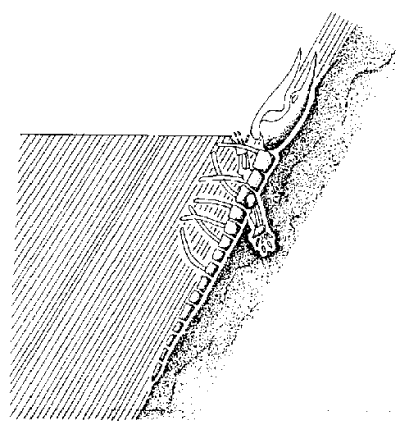 |
Science Frontiers ONLINE No. 104: Mar-Apr 1996 |
|
|
The whale-on-its-tail fossil
Near Lompoc, California, is a large deposit of diatomaceous earth, so-called because it is composed almost entirely of countless billions of exquisitely sculptured diatom skeletons. Uniformitarian geologists have steadfastly maintained that such diatomaceous-earth deposits require millions of years to form as the tiny skeletons sink slowly to the sea floor. At Lompoc, however, embedded in the thick layer of diatomaceous earth is the fossil of a large whale apparently standing on its tail. How could this whale fossil have maintained its position and integrity over hundreds of thousands of years as it was buried millimeter by millimeter? Wouldn't the bones have been quickly scattered?
Creationists have pointed to this whale as proof that the Lompoc diatomaceous-earth deposit was formed catastrophically, interring the whale almost instantaneously, and burying doctrinaire uniformitarianism at the same time. (Creationists want to "shorten" geological time to fit Biblical schedules.)
But was the whale really entombed on its tail? Creationist geologists studied the Lompoc deposit and put a different slant on the story but not on its ending.
"Contrary to some reports that have circulated, the 80-90 ft (24-27 m) long fossilised baleen whale found in April 1976 in an inclined position in a diatomite unit in the Miguelito Mine at Lompoc, California, was not buried while 'standing on its tail'. An onsite investigation has revealed that the diatomite unit which entombed the whale is also inclined at the same angle, the whale having been buried in the diatomite unit while both were in the horizontal position, and subsequent earth movements having tilted both. Nevertheless, this whale fossil still bears testimony to its catastrophic burial, and thus the catastrophic deposition of the enclosing diatomite.
"The current uniformitarian (slow and gradual) model for diatomite deposition, as seen in the Guaymas Basin of the Gulf of California, is not capable of explaining the purity of the Lompoc diatomite...the deposition rate is too slow to avoid corrosion and scavenging of the bones. both of which are absent from the Lompoc whale bones."
(Snelling, Andrew A.; "The Whale Fossil in Diatomite, Lompoc, California," CEN Technical Journal, 9:244, 1995. This is an Australian creationist journal.)
Comment. The Lompoc whale fossil does suggest very rapid deposition, but it does not prove that 4.5 billion years of geological history can be compressed into the requisite 6,000 years!
Reference. The Lompoc deposit and many others like it are cataloged in ESD2 in the catalog volume: Neglected Geological Anomalies. For details on this book, visit: here.
 | The Lompoc diatomite bed (left) and fossile whale, as found excavated in 1976. |